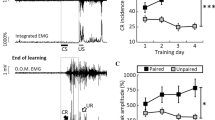Abstract
The hippocampus is needed for at least one kind of trace classical conditioning, the air-puff eye-blink paradigm. A simple model of region CA3 predicts three basic, quantitative observations of the learning behavior of rabbits. One particular quantified prediction is the learnable trace interval. The boundary region of the reliably learnable trace interval represents a phase transition. Within this transition, three behaviorally distinguishable modes are expressed: failure to blink; blink too soon; and occasionally, appropriate predictive blinking. In the region of the phase transition, there is a small sub-interval where the behavioral modes fluctuate rapidly from trial to trial for individual simulations. Such observed fluctuations are an experimental prediction by the model. The discussion also includes a brief conjecture concerning the underlying cause of the phase transition and the fluctuations.
Similar content being viewed by others
References
Alvarado M, Rudy J (1995) Rats with damage to the hippocampal formation are impaired on the transverse-patterning problem but not on elemental discriminations. Behav Neurosci 109:204–211
August DA, Levy WB (1999) Temporal sequence compression by an integrate-and-fire model of hippocampal area CA3. J Comput Neurosci 6:71–90
Blum KI, Abbott LF (1996) A model of spatial map formation in the hippocampus of the rat. Neural Comput 8:85–93
Dusek JA, Eichenbaum H (1997) The hippocampus and memory for orderly stimulus relations. Proc Natl Acad Sci 94:7109–7114
Gormezano I, Kehoe EJ, Marshall BS (1983) Twenty years of classical conditioning research with the rabbit. In: Epstein AN (ed) Progress in psychobiology and physiological psychology. Academic Press, New York, NY, pp 197–267
Kelso JAS (1995) Dynamic patterns: the self-organization of brain and behavior. MIT Press, Cambridge, MA
Kim JJ, Clark RE, Thompson RF (1995) Hippocampectomy impairs the memory of recently, but not remotely, acquired trace eye-blink conditioned responses. Behav Neurosci 109:195–203
Levy WB (1989) A computational approach to hippocampal function. In: Hawkins R, Bower G (eds) Computational modeling of learning in simple neural systems. Academic Press, Orlando, FL, pp 243–305
Levy WB (1990) Maximum entropy prediction in neural networks. In: International joint conference on neural networks, vol I, pp 7–10
Levy WB (1994) Unification of hippocampal function via computational considerations. In: INNS world congress on neural networks, vol IV, pp 661–666
Levy WB (1996) A sequence predicting CA3 is a flexible associate that learns and uses context to solve hippocampal-like tasks. Hippocampus 6:579–590
Levy WB, Sederberg PB (1997) A neural network model of hippocampally mediated trace conditioning. In: IEEE international conference on neural networks, vol I, pp␣372–376
Levy WB, Steward O (1979) Synapses as associative memory elements in the hippocampal formation. Brain Res 175:233–245
Levy WB, Steward O (1983) Temporal contiguity requirements for long-term associative potentiation/depression in the hippocampus. Neuroscience 8:791–797
Levy WB, Wu X, Baxter RA (1995) Unification of hippocampal function via computational/encoding considerations. In: Amit DJ, del Guidice P, Denby B, Rolls ET, Treves A (eds) Proceedings of the third workshop on neural networks: from biology to high energy physics. Intl J Neural Sys, 6(Suppl). World Scientific Publishing, Singapore, pp 71–80
Levy WB, Sanyal A, Rodriguez P, Sullivan DW, Wu XB (2005) The formation of neural codes in the hippocampus: trace conditioning as a prototypical paradigm for studying the random recoding hypothesis. Biol Cybern 92:409–426
McEchron MD, Disterhoft JF (1997) Sequence of single neuron changes in CA1 hippocampus of rabbits during acquisition of trace eyeblink conditioned responses. J Neurophysiol 78:1030–1044
Minai AA, Levy WB (1993) Sequence learning in a single trial. In: World congress on neural networks (WCNN), vol 2, pp 505–508
Morris R (1984) Developments of a water-maze procedure for studying spatial learning in the rat. J Neurosci Methods 11:47–60
Moyer JR Jr, Deyo RA, Disterhoft JF (1990) Hippocampectomy disrupts trace eye-blink conditioning in rabbits. Behav Neurosci 104:243–252
Prepscius C, Levy WB (1994) Sequence prediction and cognitive mapping by a biologically plausible neural network. In: INNS world congress on neural networks, vol IV, pp 164–169
Rodriguez P, Levy WB (2001) A model of hippocampal activity in trace conditioning: where’s the trace? Behav Neurosci 115:1224–1238
Scoville WB, Milner B (1957) Loss of recent memory after bilateral hippocampal lesions. J Neurol Neurosurg Psychiatry 20:11–21
Smith AC, Wu XB, Levy W (2000) Controlling activity fluctuations in large, sparsely connected random networks. Network 11:63–81
Solomon PR, Vander Schaaf ER, Thompson RF, Weisz DJ (1986) Hippocampus and trace conditioning of the rabbit’s classically conditioned nictitating membrane response. Behav Neurosci 100:729–744
Sullivan DW, Levy WB (2003) Synaptic modification of interneuron afferents in a hippocampal CA3 model prevents activity oscillations. In: International joint conference on neural networks (IJCNN) 2003 proceedings, pp 1625–1630
Wu X, Levy WB (2005) Increasing CS and US longevity increases the learnable trace interval. Neurocomputing 65–66:283–289
Acknowledgment
This work was supported by a grant from the National Institutes of Health, NS041582.
Author information
Authors and Affiliations
Corresponding author
Rights and permissions
About this article
Cite this article
Howe, A.G., Levy, W.B. A hippocampal model predicts a fluctuating phase transition when learning certain trace conditioning paradigms. Cogn Neurodyn 1, 143–155 (2007). https://doi.org/10.1007/s11571-006-9012-7
Received:
Accepted:
Published:
Issue Date:
DOI: https://doi.org/10.1007/s11571-006-9012-7




